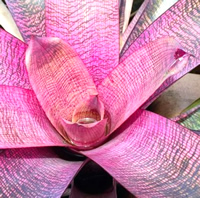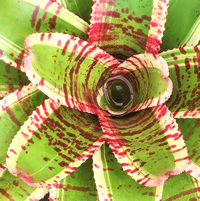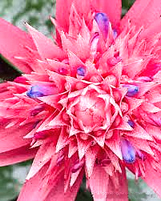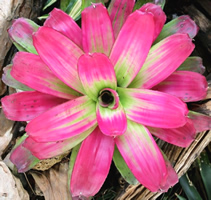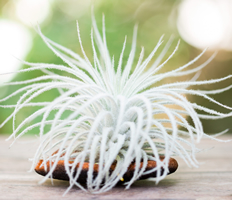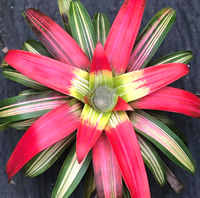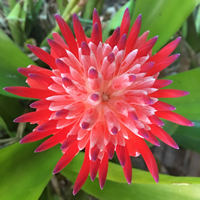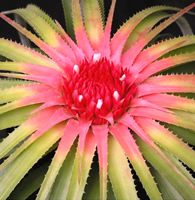
Bromeliad Information
Bromeliad plants provide an exotic touch to the home garden and bring a sense of warm tropical destinations. Growing a bromeliad is easy and brings interesting texture and color to the garden, interior and exterior.
Most bromeliad species come from the tropics or sub tropics so these plants love warm indirect sunny positions in the garden or on unit balconys.
Following, are a few simple steps to keep you enjoying these beautiful plants that realy are long lasting and low care.
1. Provide bright light without
direct sun exposure.
2. Maintain optimal humidity.
3. Keep air flowing around the plants.
4. Make sure the plants stay moist but not soggy.
5. Provide adequate drainage.
6. Fertilize sparingly.
Bromeliaceae Plant Family
The bromeliad family contains over 3000 well described species in approximately 57 genera. As well there are thousands of hybrids, many registered as well as many unregistered.
Bromeliads are divided into groups called genera. Different genera and species require varying amounts of light, water and humidity; however, the majority of plants in each genus often have the same general cultural requirements. In cultivation, the most commonly found genera are Aechmea, Cryptanthus, Dyckia, Guzmania, Hechtia, Neoregelia, Nidularium, Orthophytum, Tillandsia and Vriesea.
Appearance:
Bromeliads are a varied group of plants, adapted to a number of climates.
All bromeliads are composed of a spiral arrangement of leaves called a ‘rosette’.
The bases of the leaves in the rosette may overlap tightly to form a ‘tank’ or water reservoir. These ‘tank bromeliads’ rely less heavily on their roots for water & nutrient absorption & are more often found as epiphytes.
The more ancient terrestrial bromeliads don’t have this water storage capacity & rely primarily on their roots for water & nutrients.
There are also the non tank epiphytes like the grey leaved Tillandsias that gather water & nutrients only from the leaf trichomes.
The foliage takes different shapes, from needle thin to broad & flat, symmetrical to irregular, spiky to soft.
The foliage is the most widely patterned & coloured of any plant in the world.
All bromeliad have trichomes (scales) which serve as a very efficient absorption system. In the desert, they help reduce water loss & shield the plants from solar radiation. These plants are so heavily covered that they appear silvery-white. On many species (especially in more humid areas), the scales are smaller & less noticeable. Sometimes they form patterns & banding on the leaves.
The inflorescence (group of flowers arranged on a stem called a scape) is also regarded as considerably more diverse than any other plant family. Some reach up 10 metres tall while others are as small as 2-3 mm. With few exceptions, they are produced from the centre of the rosette. They may be branched or simple, retaining their colour from several weeks to 12 months. The scape may be long with the flowers held away from the plant (eg Alcantareas) or it may be short with the flowers nestled in the rosette (eg Neoregelias).
Root systems vary from terrestrial species with complex root systems to epiphytic species with hard wiry roots to attach to trees & rocks.
Some bromeliads are faintly scented while others are heavily perfumed (Tillandsia cyanea resembles the smell of clove spice).
The largest bromeliad is Puya
raimondii, which reaches 3-4 metres tall with a flower spike 10-12 metres
tall & the smallest is probably Tillandsia usneoides.
Habitat:
Bromeliads are native to the tropical & sub tropical regions of South America. They grow from Virginia in Southern USA through to Argentina. Areas with particular abundance of species include Mexico, some regions of Central America, the West Indies, eastern & southern Brazil & the Andean region from northern Chile to Colombia.
Most bromeliads grow in moist mountain forests between 1500 & 2500 metres altitude where they have cloud envelopment for several hours a day & the trichomes capture moisture. A few inhabit nearly rainless coastal deserts. Some survive frequent flooding. Others grow so close to the ocean that they are subjected to salt spray that would kill most other plants.
However, no bromeliad can tolerate prolonged subzero temperatures, although a few species have adapted to high tropical mountains where nights can be frosty eg some Tillandsia still occur at 4000 – 4300 metres in Peru. Puya raimondii grows at these altitudes in the Peruvian Andes & Puya nivalis approaches the snowline in Colombia at 4800 metres.
The species Pitcairnia feliciana
is the only bromeliad that is not native to the Americas. Its discovery in
Guinea in West Africa was unexpected & it is thought to have reached Africa
by long distance dispersal 12 million years ago.
Cultivation & uses
Humans have been using bromeliads
for thousands of years. The Incas, Aztecs, Maya & others used them for
food, protection, fibre & ceremony. The pineapple is the only member used
for food; however several species including Caroa (Neoglaziovia) are used
as a source of fibre. Pineapple stems are a source of the enzymes bromelain
& papain which are used as a meat tenderizer.
Life Cycle:
With rare exceptions, bromeliads only flower once & the plant slowly dies after blooming. Plants mature & bloom over differing time periods from one to many years. A strong change in conditions may trigger premature flowering especially with neoregelias.
The plant stops producing leaves & produces its flower & it will not produce leaves again. It will however vegetatively produce one to many new “offsets” or “pups”. These plants will feed off the mother until they are large enough to set roots & survive as a separate plant. The mother may survive a generation or two before finally dying thus an attractive clump is formed. Propagation of these is seldom necessary. Other bromeliads look best as single plants & the pups should be removed & established on their own.
Pups are usually produced
near the base of the plant, inside the sheath of a leaf. Sometimes they are
produced on long stolons or atop the inflorescence of the mother.
Propagation
Propagation can be carried out in two ways: by vegetative offsets and by seeds.
Vegetative Propagation:
Pups should be removed when they are one third to one half the size of the parent plant (taking into consideration the width & height). This will allow the mother to produce more pups. The pup should have a firm, brown base & ‘good form’ before being removed. If it feels ‘soft’, leave it for a bit longer. The first pups produced are always the strongest.
Stoloniferous pups (growing on stems) can be removed with secateurs. For pups closely attached to the mother, use a clean saw edged knife, cutting as close as possible to the mother without damaging her soft tissue. Damage to the trunk of the parent invites bacterial or fungal attack, the same applying to the pup if cut too short. It takes months for a pup to recover from too short a cut or being removed when too little. Some dust the mother & pups with fungicide (no copper). Pups growing from the centre of the mother are more difficult to remove & take practice.
Leave the pups for 24 hours before planting. Many use peat or sand or vermiculite/perlite initially till the offset produces roots before potting on into the usual potting medium. Others plant straight into the normal potting mix & make sure the pup is not too deeply planted yet is stable.
Sometimes it’s necessary to tip the plant out of the pot so you can see what you are doing. Also carefully remove any leaves obstructing the view of the base of the pup.
Give the mother a small amount of controlled release fertiliser & she will probably produce one or two more batches of pups.
The best time to remove pups is in the warmer months – mid October through to March, though some avoid the hottest part of this period. Pups removed in the cooler months will not grow & may rot.
Some bromeliads produce small grass like pups called adventitious pups eg Alcantareas. Remove them when they are 10-15 cm tall.
Vegetative propagation does not apply to all bromeliads eg some species of Tillandsia do not pup at all, but produce lots of seeds to carry on the species.
Bromeliads used in Landscaping
Bromeliads add great colour & structure to any garden – provided they can be protected from frosts and are grown according to their specific requirements. It’s important to plant the different varieties in the correct position to get good form & colour. They are tropical & exotic in appearance.
The larger growing bromeliads eg Alcantareas & Aechmea Carcharodon Tiger make great specimen plants.
They can be put in the garden still in their plastic pots – dig a hole to hide the pot & cover with some mulch eg Bark Chips. This allows the plants to be moved around as necessary.
Alternatively, bromeliads can be planted in the ground into 20-30cm layer of composted pine bark to ensure good drainage.
Epiphytic varieties can be
attached to trees & logs in subtropical climates.
|
|
|
|
|
| Aechmea |
Alcantarea |
|
|
|
|
|
_____________________________________________Copyright © June 2021______________________________________________
